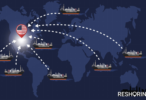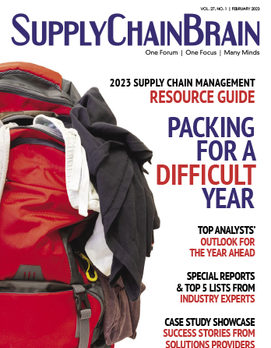
Think Tank
The Power of Data in Negotiating Shipping Contracts

Regardless of where you work or your role in the supply chain, you likely witnessed dramatic changes over the past two years. We may never fully come to terms with the heartbreaking human cost of the pandemic and it will likely be years before we truly understand its long-term impact on commerce or how it will impact supply chains in the future. Nor is the pandemic over.
We do know; however, that some of the shifts we’ve witnessed are here to stay. Most notably, online sales were already increasing well before COVID-19, but the pandemic dramatically accelerated e-commerce adoption and changed consumers’ habits and expectations. Some sectors like online grocery sales saw exponential increases practically overnight even as Amazon made free next-day shipping ubiquitous. Now, in some markets same-day delivery is increasingly the norm.
Even as case counts decreased and consumers flocked back to stores, online purchases remained robust. The U.S. Department of Commerce’s latest quarterly survey estimated that e-commerce accounted for 14.5% of all retail sales in the fourth quarter of 2021. Online purchases also totaled $870.8 billion for the year, a 14.2% increase over 2020, when they accounted for 13.6% of total annual sales. In 2021 they accounted for 13.2% of total sales.
All of this points to a parcel shipping conundrum. Shipping acumen was always important, but in an era of e-commerce it’s crucial for most companies. This includes all omni-channel retailers and of course all B2C and B2B e-commerce businesses. Secondly, consumers increasingly expect free shipping.
Supply chain professionals of course know there is no such thing as free shipping. Instead “free” delivery is a reflection of how much of the shipping costs a business can absorb and still remain competitive on price. And that largely depends on the agreement they have in place with their carrier.
Unfortunately, most companies do not have favorable shipping contracts in place. And far fewer know how the prices, terms and conditions they agreed to compare with those attained by their competitors.
This lack of transparency is purposeful and problematic for businesses, but it isn’t new. For decades FedEx and UPS have thrived in an environment that is complex by design and governed by a constantly changing litany of new rules and fees governing everything from zones to package dimensions.
Historically only the savviest shippers, those who hired negotiation experts and who had data to draw on, were able to secure truly favorable carrier contracts. Too many businesses simply accepted what was offered — never knowing how much money they left on the table.
That approach is no longer sustainable. Not only is shipping a true competitive differentiator in e-commerce — imagine if you pay 25% more than a competitor — but it’s also more expensive than ever. Specifically, FedEx and UPS have shown that they are more determined to increase their profits than ever before. And the primary way they are doing so is by raising parcel shipping prices.
Consider their most recent earnings. Despite admitted network capacity constraints and a labor shortage, both FedEx and UPS broke revenue records in the fourth quarter of 2021. In December, FedEx achieved its highest operating income in the company’s history and UPS achieved its most profitable quarter ever. What was the key driver of these record-breaking gains? You guessed it: much higher per-parcel shipping prices.
Surprises Hurt
It takes two to tango. Both FedEx and UPS announced a general rate increase of 5.9% for 2022. In response, more than a few shippers looked at their projections, increased their budgets by 5.9% and considered the extra outlay a cost of doing business during a volatile time.
Unfortunately, the real-world price increases enacted by both carriers for 2022 are significantly higher than 5.9%. FedEx and UPS introduced numerous new surcharges, fees and rules in 2021. Hidden in the fine-print details of their shipping contracts, they cover everything from package dimensions to zones and other parameters that dramatically impact how much it costs to ship a package. Importantly, neither company included these in their 5.9% rate card increase for 2022.
To find out how much the average company will really pay this year our data scientists created a model that applied all of the new surcharges, rules and fees — and the 5.9% increase — to millions of real shipments our customers made the previous year. The resulting apples-to-apples comparison was eye opening:
- Less than 3% of companies will see a 5.9% or less increase in their parcel shipping costs in 2022;
- UPS’s 5.9% rate increase will actually equate to a 10.25% increase for most companies;
- FedEx’s 5.9% rate increase will actually equate to a 12.86% increase for most companies; and
- Small businesses that use FedEx Ground Economy, formerly SmartPost and historically the least expensive shipping option for small businesses, will see an increase of 26%.
The hits don’t end there. In response to rising diesel and jet fuel costs because of the horrific attacks in Ukraine, both FedEx and UPS are also increasing their fuel surcharges not only in proportion to the rising cost per gallon, but also in the fuel surcharge tables they use to publicly calculate their adjustments. FedEx for example increased its fuel surcharge table an extra 1.75% across the board in early April — drawing almost another 2% of profit out of its already increasing fuel surcharge.
These developments reflect a sobering reality for shippers: businesses that simply accept the contracts their carriers give them for 2022 will see their costs increase dramatically. Now, more than ever, shippers must not only negotiate, but do so effectively.
Negotiations Begin With Data
Mathematician Clive Humby is credited with coining the phrase “data is the new oil.” Of course in the supply chain, it’s not entirely true. Advancements in green energy aside, trucks and planes run on oil, not data.
When it comes to negotiating favorable contracts with carriers though, the power and importance of data cannot be overestimated. Negotiating without data is not really negotiating at all, especially today when carriers have made it clear they are willing to walk away from business. That is why it is so important for shippers to build a compelling business case.
That requires data and more specifically for companies to attain true shipping intelligence. Just like they embraced business intelligence to organize, visualize and act on vast amounts of information, businesses must now do the same for shipping. Not only should they have the ability to monitor their shipping in real time, but they must also understand how the rates they secure compare to those of their competitors and peers. And they must be able to identify and act on opportunities to save money when they arise.
Specifically, in order to negotiate effectively every shipping operation should know their shipping vital factors — the metrics we found were most crucial for negotiation success in our multi-year survey of hundreds of the world’s most successful shipping operations. These factors include:
- Total shipping spend;
- Surcharge spend;
- Average cost per shipment;
- Weight — including average weight and the percentage of packages billed at their dimensional weight;
- The percentage of shipments that hit carriers’ minimum charges; and
- Which zones you ship to most.
Armed with this data, you can begin to build your business case. Although it will differ for each company and its unique shipping profile — and ultimately determine how negotiations will proceed — there are several points all businesses should keep in mind:
Monitor your contracts. Countless companies find costly surprises in their quarterly shipping bills because terms — such as negotiated surcharge rates — often have different expiration dates than the contract. Remember that most contracts are designed to be complex and include constantly-changing variables that require technology to keep track of.
Conduct a shipping audit. A thorough audit typically delivers savings of 1 to 3%. Modern platforms let companies keep 100% of the refunds and make an audit one of the easiest things a company can do to immediately uncover savings.
It’s not too late to negotiate for 2022. Negotiating with your carrier should be viewed as a continual exercise to ensure that your organization’s supply chain benefits from the best shipping prices, terms and conditions.
These are some of the many things shippers should consider during what will be another memorable year. They, and the supply chain leaders they work with, will be best served when they aggressively negotiate their carrier contracts, define their RFP process, stick to deadlines, remain firm and avoid the temptation to accept the first offer. Now is also the time to switch carriers if it is advantageous, and if that’s not possible, look at how they can become carrier-agnostic in the future.
Josh Dunham is co-founder and CEO of Reveel.




